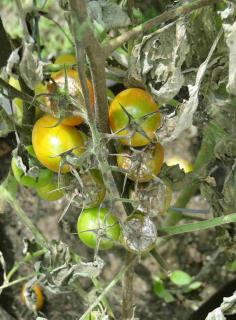

Tomato late blight is one of the most devastating diseases because downy mildew spreads extremely quickly.
As soon as black spots appear on leaves, you should prepare for this worst of tomato blight, the late tomato blight
Here is how to avoid this blight and treat this disease with organic techniques.
Read also:
Tomato blight is a fungus with latin name Phytophthora infestans that results in a devastating fungal disease related to downy mildew.
As for all mushrooms, two factors meet to provide the most favorable conditions to its growth: heat and moisture.
Once contaminated, tomato plant leaves start to blacken. If not treated, the disease can spread to an entire crop in just days and destroy the harvest.
Most important to avoid tomato blight is to space tomato plants well apart. If air circulates well, you will guarantee quicker drying of leaves.
Tightly packed tomato plants lead to a closed, stuffy environment that is exactly what downy mildew needs to grow. Downy mildew spreads along wet leaves, so the longer they stay wet, the higher the risk of becoming contaminated by the tomato blight.
When watering, never wet the leaves: only bring water to the foot of the plant.
Lastly, do all you can to avoid having leaves or fruits touching the soil. Soil propagates diseases and fungus such as downy mildew very well. Plants touching the ground will potentially be infected with mildew.
 As of today, there is no curative treatment against downy mildew. Observing your plants very regularly is the best manner to keep downy mildew from spreading.
As of today, there is no curative treatment against downy mildew. Observing your plants very regularly is the best manner to keep downy mildew from spreading.
As soon as black or brown spots appear on the leaves, remove and destroy them to eliminate any trace of the fungus.
Use clean pruning shears sterilized with alcohol after each cut to avoid contaminating health plants.
After that, treat with Bordeaux mixture and repeat this surveillance on a regular basis until about 2 weeks before harvesting the tomatoes.
Another solution is to treat with baking soda soap spray: 1 table spoon baking soda and 1 table spoon liquid beldi soap for 1 quart (1 liter) water.